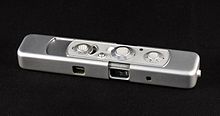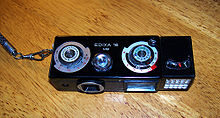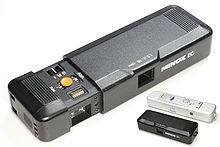Miniature camera
In miniature cameras is photographic cameras with an aspect ratio less than about 2 cm edge length.
history
The (not yet standardized) miniature cameras of the 1850s often used photographic plates with a side length of 2.5 cm, for example the apparatus by Thomas Skaife ( 1858 ) and Charles Piazzi Smyth ( 1859 ff.). These negatives were enlarged , which was completely unusual at the time .
Camera types
Viewfinder cameras
Analog miniature cameras are almost exclusively offered as viewfinder cameras. With digital viewfinder cameras, it is often possible to use the rear display instead of the viewfinder.
Single-lens reflex cameras
With Minolta and Asahi Pentax, only two manufacturers offered a SLR pocket camera, for the other types of film there were no SLR cameras at all. The two models received a lot of attention in specialist circles and subsequently also a modest distribution. But they remained the exception.
Films and formats
Minox 8mm x 11mm
The Minox 8x11 cameras for the 8 mm × 11 mm format are especially miniature cameras; in fact, one would have to differentiate between these and 16 mm cameras, as the jump from the 24 mm × 36 mm format to the pocket film is just as big as from pocket format to Minox . Not only is the format extremely small, but also the film itself, its width is 9.5 mm. This is particularly important for espionage applications in order to be able to transport it as undetected as possible. In private hands the Minox system has only been used by a few committed amateurs, but it has found a consistently modest distribution over many years.
16mm film
In the early 1960s, several cameras for 16 mm cine film came on the market. However, this format was not widely used and was forgotten again with the appearance of the pocket film. This was because Kodak did not want to offer film cartridges for it. For example, Rollei had to assemble and distribute films for its Rollei 16 itself. Another well-known German camera is the Edixa 16 , it used the same cartridges according to DIN standard 19022. Both cameras exposed the format 12 mm × 16 mm. Originally, double-sided perforated film was also used, which had to be self-assembled, i.e. wound from a narrow-film camera reel. In 1970 Minolta introduced a ready-made cassette with 16 mm film, which also used the recording format 12 × 16 mm.
Type 110
With the pocket film introduced by Kodak in 1972 , miniature cameras became very fashionable; this 13 mm × 17 mm film was extremely widespread in the 1970s, which then changed again in the course of the following decade. It was of considerable importance not only for entry-level cameras, but also for those in the medium price range around 300 DM.
Disc film
Kodak tried with the disc film , a disc-shaped film with the image size of 8 mm × 10 mm to revive the idea of pocket camera new, but it remained at a barely noticeable success in the 1980s. In contrast to the pocket film, only very few camera manufacturers acquired a license; There weren't any high-quality models to buy, so this film was of no importance to amateur photographers.
Digital sensors
Since large digital sensors are expensive to produce, the first consumer digital cameras appeared in pocket format. They found widespread use very quickly and now make up the largest share of photo cameras. The forerunners of the digital cameras were the still video cameras of the late 1980s, they recorded an analog signal on a floppy disk.
properties
height and weight
In the case of upscale miniature cameras, the size plays an important role; they are elaborately designed to be as small as possible. Simpler models, especially the standard pocket cameras of the 1970s, are only reasonably small, but not extremely small. When it comes to digital cameras, manufacturers usually offer two product lines, on the one hand extremely small cameras, which take the position of pocket cameras, and slightly larger models, which are usually easier to operate, have a swiveling display and can be equipped with a filter holder for the lens .
costs
Analog miniature cameras are on par with 35mm cameras in terms of both acquisition and operating costs. An extra charge is only required for extreme miniaturization; this applies especially to the Minox cameras. In the case of digital cameras, sensors for small images are cheaper than for small images, which consequently also applies to the entire camera. Here, too, extremely small cameras are a bit more expensive.
Depth of field
Due to the short focal length of their lenses, miniature cameras invariably have a large depth of field; with them it is almost impossible to let the background stand out from the foreground through blurring. On the other hand, objects that are far apart can easily be focused at the same time, which enables effects that are already unthinkable in the case of 35mm cameras. The large depth of field also makes it easy to be satisfied with an approximate focus setting.
picture quality
With the pocket format, of course, only a limited image quality is possible, which, however, reaches an astonishing level with careful work. This is helped by the fact that lenses can be designed for a small image circle with a particularly high resolution. With the Minox cameras, the extremely small recording format only has a resolution sufficient for prints in the format of around 13 cm × 18 cm. When used as a spy camera, a special document film is used that has an extremely high contrast, i.e. does not reproduce gray tones, but is extremely high-resolution.
Areas of application
Miniature cameras can hardly be used universally; most of them are optimized for their size.
As a compact, winking and always-with-you solution for snapshots, most of the cameras made for type 110 film are well suited. The similarity with the spy cameras from Minox and the mostly robust, handbag-compatible design and size may have contributed to its widespread use . In the long term, the compact 35mm camera, which was sometimes only slightly larger, was superior thanks to the flash, zoom and film selection.
But even the Pentax auto 110 system camera did not have an extensive range of lenses. However, there are no technical reasons for this; it would be entirely possible to develop a comprehensive system. Miniature cameras are advantageous when used on binoculars or telescopes; they work particularly well with an adapter. While toy cameras can be found in both the 110 and the regular 135 format, single-use cameras seem to remain the domain of the more widely used 35mm format.
Web links
Individual evidence
- ↑ Camera of the month - SIDA packaging variants, page on archiv.club-daguerre.de, accessed on September 9, 2015.




